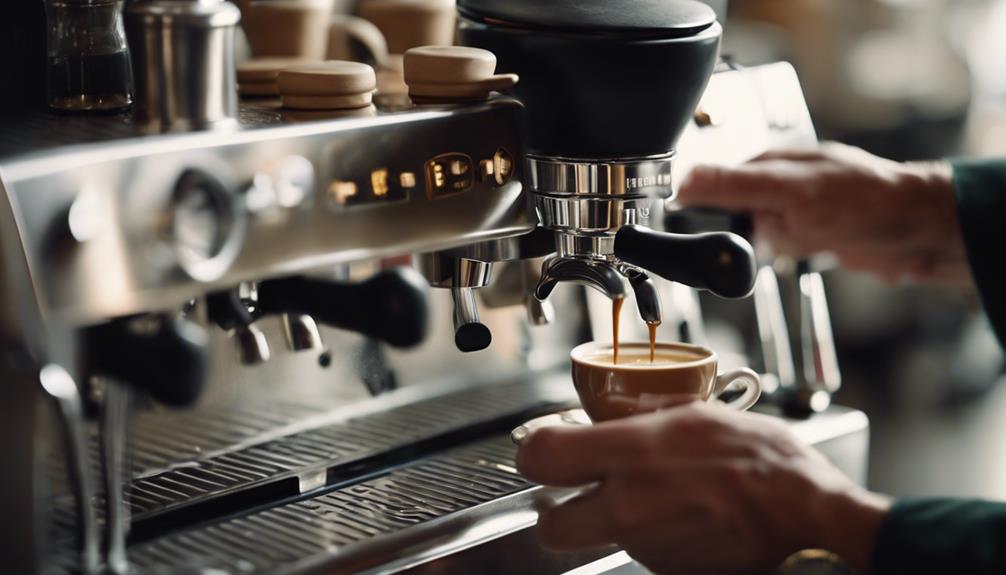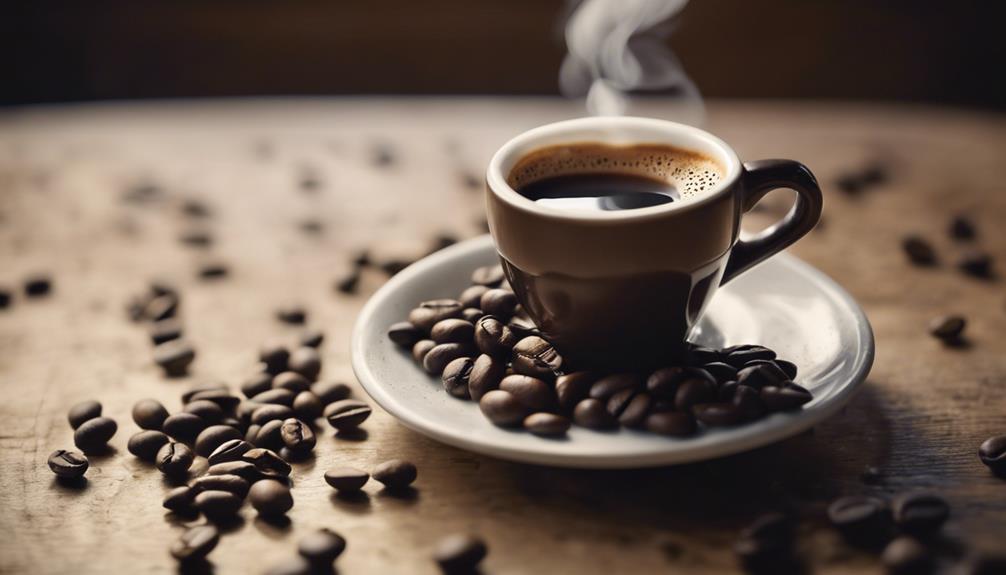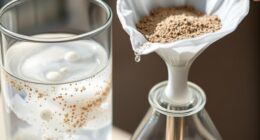To perfect long espresso extraction times, strive for a well-rounded flavor profile through adjustments in grind size, water temperature, and extraction time. Lengthier extraction brings out sweetness and body, whereas shorter times help balance acidity. Factors such as grind size and water temperature play a significant role in determining taste. Prevent bitterness by closely monitoring extraction time and tweaking grind size accordingly. Fine-tune dosage and tamping pressure for optimal outcomes. Experiment with various grind sizes to discover a nuanced flavor experience. Attain a harmonious brew by pinpointing the ideal extraction point. Balancing these components will elevate your coffee enjoyment to a whole new level.
Key Takeaways
- Experiment with grind size adjustments for optimal extraction control.
- Avoid exceeding 40 seconds for extraction time.
- Use coarser grind for smoother flavor in long espresso.
- Focus on grind size adjustments for flavor perfection.
- Aim for a balanced flavor profile in long espresso shots.
Understanding Long Espresso Extraction
To grasp the concept of long espresso extraction, consider it as a method that prolongs the brewing process to achieve a milder and more balanced flavor profile. When brewing lungo shots, the water-to-coffee ratio is typically higher than in traditional espresso, leading to an extended extraction process. This longer extraction time results in a smoother taste profile with reduced intensity compared to standard espresso.
The light body and decreased crema of lungo shots are a direct outcome of this method. By balancing the intensity of espresso with the smoothness of drip coffee, lungo shots offer a unique experience for coffee enthusiasts. Mastering espresso extraction involves understanding this balance between intensity and smoothness, ensuring that the flavors are harmoniously combined.
Experimenting with different extraction times and ratios can help you tailor your brew to suit your preferences, allowing you to enjoy a well-crafted cup of long espresso tailored to your taste.
Importance of Extraction Time Measurement

Monitoring extraction time during the preparation of long espresso shots is essential for achieving consistent flavor and quality in your coffee. Extraction time measurement typically falls between 35-45 seconds for a balanced taste profile.
Longer extraction times for lungo shots enable a more extended interaction between water and coffee grounds, extracting various flavor compounds. It's important to monitor extraction time to prevent over-extraction, which can lead to a bitter and astringent taste in your espresso.
Consistent extraction time measurement guarantees repeatability in flavor and quality for your long espresso shots. The extended extraction times associated with long espresso shots help extract more coffee solubles, resulting in a fuller-bodied and more nuanced flavor profile.
Factors Influencing Extraction Time

Grind size greatly influences how long it takes to extract an espresso. The finer the grind, the shorter the extraction time typically becomes.
Water temperature and pressure also play vital roles in determining the length of the extraction process.
Grind Size Impact
Selecting the appropriate grind size greatly influences the extraction time for long espresso shots. The table below illustrates how grind size impacts extraction times, flavor profile, and consistency in long espresso shots.
| Factors to Consider | Impact on Extraction Time & Flavor Profile |
|---|---|
| Grind Size | Finer grind sizes lead to shorter extraction times, resulting in a more intense flavor profile. Coarser grind sizes extend extraction times, offering a more balanced and nuanced taste. Consistency in grind size is essential for maintaining flavor intensity. Adjusting grind size allows control over extraction, ensuring a well-balanced shot. |
Water Temperature Effects
To optimize extraction time and flavor balance in long espresso shots, closely monitoring water temperature is essential. The temperature of the water used during espresso extraction has a substantial impact on the extraction process by influencing how quickly coffee solubles are dissolved.
The ideal water temperature for espresso extraction typically falls between 195-205°F. Higher water temperatures can expedite the extraction process, potentially resulting in a faster extraction time. However, this can lead to imbalances in flavor if not carefully controlled.
On the other hand, lower water temperatures may prolong the extraction time, running the risk of over-extraction and a bitter taste in the final espresso. Therefore, maintaining precise water temperature control is vital to achieving consistent and balanced espresso extraction.
Coffee Freshness Importance
Monitoring water temperature is vital for optimizing extraction time in long espresso shots; now, let's shift our focus to the importance of coffee freshness on extraction time. Fresh coffee beans play a pivotal role in achieving the best extraction time, as stale beans can lead to uneven extraction and off-flavors in your espresso.
The freshness of the beans greatly influences the release of desirable compounds during extraction, ultimately impacting the overall taste profile of your coffee. The degassing process in freshly roasted beans is also a key factor affecting extraction time. It determines how gases interact with water during the extraction process, influencing the flavor extraction.
To maintain coffee freshness, store your beans in airtight containers away from light and heat. This ensures consistent extraction times and preserves the quality of your espresso. Additionally, freshly ground coffee contributes to a more uniform particle size distribution, promoting even extraction and enhancing the overall extraction time of your espresso.
Controlling Grind Size for Extraction
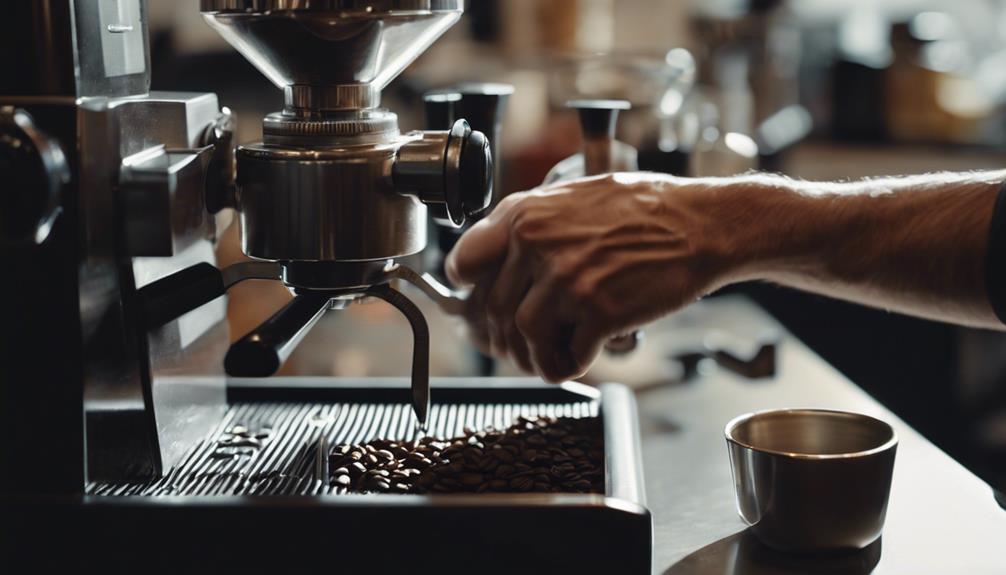
Adjust your grind size to influence the extraction speed and achieve the desired extraction time for your long espresso drinks. Grind size greatly impacts the flow rate of water through the coffee grounds, affecting the extraction process.
When aiming for a longer extraction time in your lungo or long espresso shots, opt for a coarser grind size, as this will slow down the extraction process. Conversely, if you prefer a shorter extraction time for regular espresso shots, a finer grind size is more suitable.
Experiment with different grind sizes to find the one that aligns with your desired extraction time for long espresso beverages.
Consistent grind size is essential for maintaining the flavor profiles and balance in your long espresso shots.
Customizing your grind size allows for ideal taste and a personalized extraction experience, enhancing the overall quality of your long espresso drinks.
Water Temperature's Role in Extraction
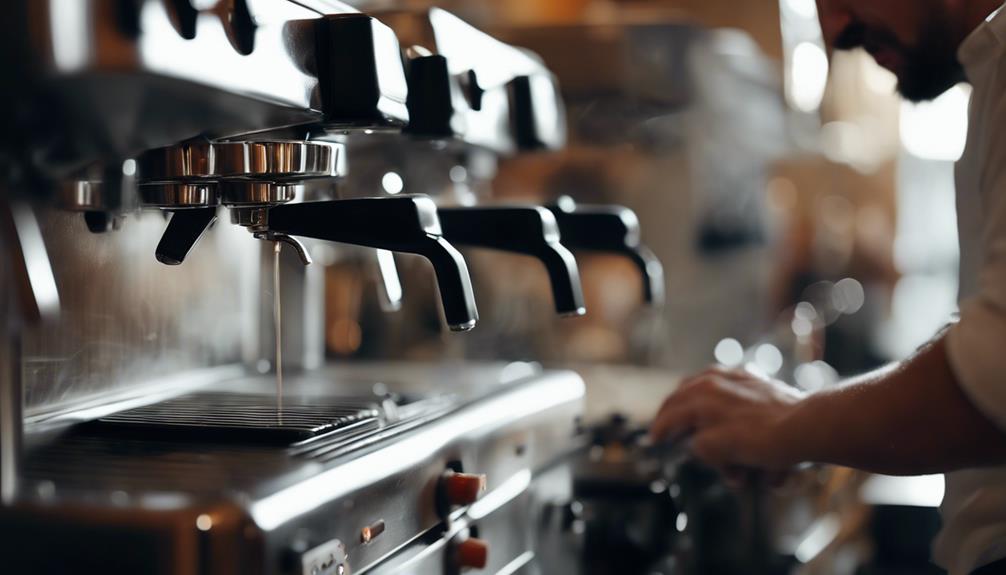
The water temperature you use when brewing espresso has a significant impact on the flavor of your shot.
At temperatures between 195-205°F, you can extract the best balance of flavors and compounds from the coffee grounds.
Optimal Water Temperature
Maintaining the ideal water temperature range of 195-205°F is essential for peak flavor extraction during long espresso preparation.
When aiming for the perfect long espresso extraction, consider the following:
- High water temperature helps break down coffee compounds, leading to a well-balanced taste profile.
- Ensuring the correct water temperature is essential for proper extraction of coffee solubles without risking scorching the grounds.
- Consistent water temperature throughout the extraction process is important to avoid under or over-extraction flavors in your long espresso shots.
Impact on Flavor
To enhance the flavor extraction process in long espresso shots, ensuring the water temperature falls within the ideal range of 195-205°F is vital. Water temperature plays a pivotal role in the extraction process, influencing the overall taste of your espresso.
If the water temperature is too high, it can lead to over-extracted, bitter shots due to the accelerated extraction process. Conversely, if the water temperature is too low, it may result in under-extracted, sour shots as the extraction time is prolonged.
Finding the right balance between water temperature, grind size, and dose is key to achieving a well-rounded flavor profile in your long espresso shots. By maintaining the water temperature within the recommended range and adjusting other variables accordingly, you can optimize the extraction process to produce a rich and balanced flavor that truly highlights the nuances of your coffee beans.
Adjusting Extraction Time Manually

For ideal results in your espresso brewing, consider manually adjusting the extraction time to fine-tune the flavor profile.
Here are some tips for adjusting extraction time manually:
- Lengthen the extraction time to enhance sweetness and body in your espresso.
- Experiment with shorter extraction times to balance acidity and reduce bitterness in your shot.
- Play around with different extraction times to uncover unique flavor notes that may be hidden in your coffee beans.
Impact of Extraction Time on Flavor
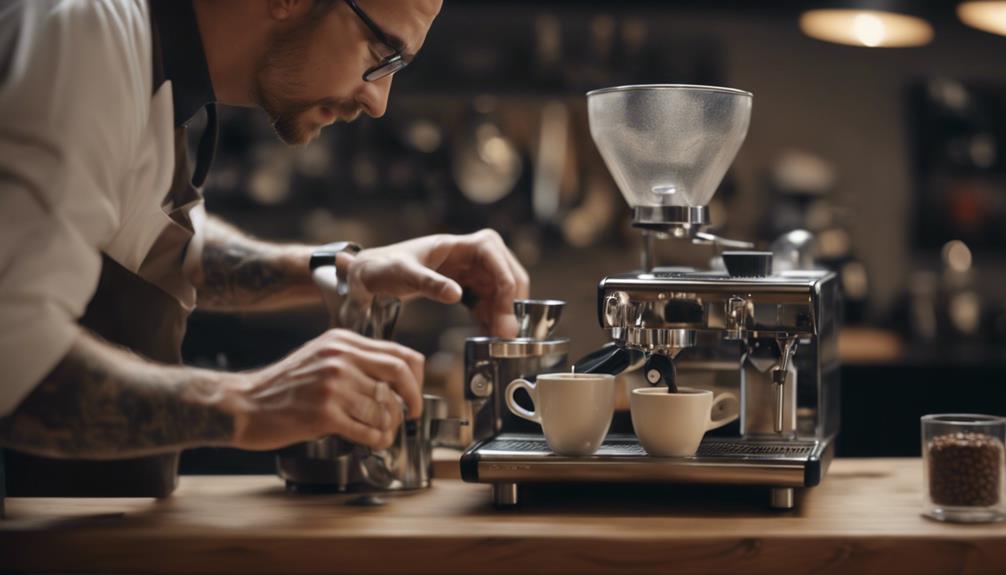
Lengthening the extraction time significantly impacts the flavor profile of your lungo shot, enhancing certain characteristics while potentially introducing new ones.
When opting for extended extraction times around 40-45 seconds, expect a milder flavor profile with a noticeable increase in acidity. This prolonged extraction allows for a greater variety of compounds to be extracted from the coffee grounds, resulting in a smoother taste.
The longer contact time between water and coffee grounds during extraction plays an important role in influencing the balance of flavors in your lungo shot. However, be mindful that this prolonged extraction may also bring forth a more pronounced bitterness compared to traditional espresso.
Despite the extended extraction time, it's essential to uphold the ideal grind size, dose, and water temperature to achieve a well-balanced lungo shot that highlights the complexities of the coffee beans.
Preventing Over/Under Extraction

Preventing over or under extraction in your espresso is crucial for achieving a balanced and flavorful shot. To guarantee you hit that perfect balance, consider the following:
- Monitor Extraction Time: Keep a close eye on the extraction time to avoid over-extraction, which can lead to bitterness, or under-extraction, causing a sour taste. Aim for the ideal range of 25 to 35 seconds for a well-rounded shot.
- Adjust Grind Size: Fine-tune your grind size to control the flow rate of water through the espresso puck. A finer grind can slow down extraction, preventing over-extraction, while a coarser grind can speed it up, preventing under-extraction.
- Taste and Adjust: Regularly taste your espresso shots and make adjustments as needed. This hands-on approach allows you to dial in the flavor balance and make sure each shot is just right.
Achieving Balance in Long Espresso

Achieving balance in long espresso extraction involves fine-tuning grind size, dose, and tamping pressure for peak flavor extraction.
When aiming for longer extraction times ranging between 30-40 seconds, it's important to find the sweet spot where the flavors harmonize without becoming overpowering.
Adjusting the grind size can impact the rate of extraction, influencing the balance of the final brew. Similarly, the dose of coffee grounds and the tamping pressure applied play significant roles in achieving the desired flavor profile.
The extended extraction time allows for the extraction of more flavor compounds, resulting in a nuanced taste experience with enhanced complexity.
Consistency is key in long espresso extraction to avoid over-extraction, which can lead to bitterness overpowering the subtle notes in the coffee.
Tips for Mastering Extraction Time
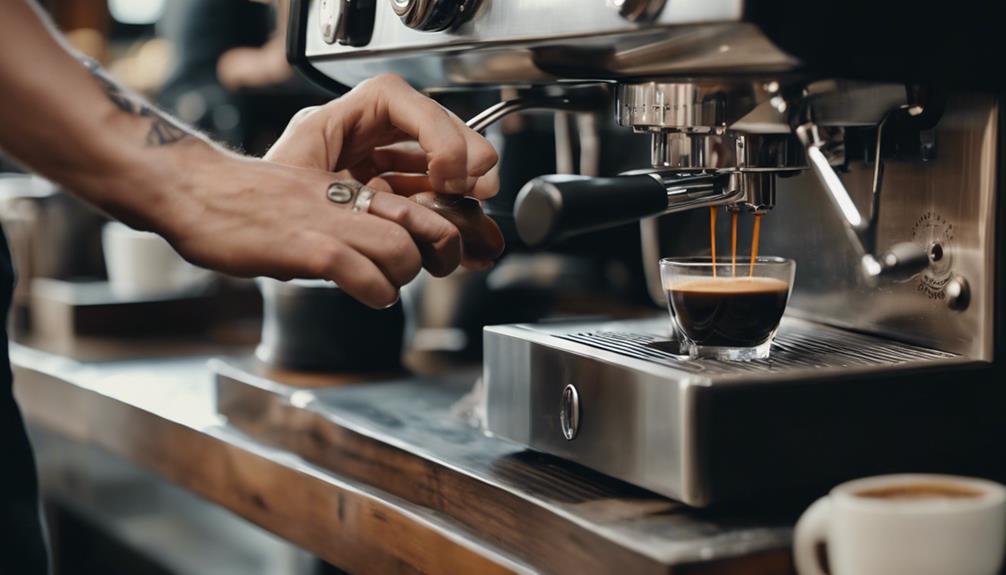
To master extraction time when brewing long espresso shots, focus on adjusting the grind size for the best flavor extraction. Here are some essential tips for achieving the perfect balance of flavors:
- Experimentation is Key: Try different grind sizes to see how they affect the extraction time and flavor profile of your long espresso shots.
- Avoid Over-Extraction: Be cautious of extending the extraction time beyond 40 seconds, as this can lead to a more diluted flavor profile.
- Seek a Smoother Flavor: Lengthen extraction times by using a coarser grind size for a milder taste and smoother flavor in your long espresso shots.
Frequently Asked Questions
What Is the Long Extraction Time for Espresso?
A long extraction time for espresso typically ranges between 30-40 seconds, resulting in a lungo shot. This type of shot is brewed with more water than regular espresso, giving it a milder taste and lighter body.
The extended extraction time of a lungo results in less crema but a stronger aroma and higher acidity. It offers a unique balance between the intensity of espresso and the smoothness of a longer brew.
How Do You Extract Espresso Longer?
To extract espresso longer, adjust your grind size and dose carefully. This tweak helps maintain a prolonged extraction without messing with the taste.
By fine-tuning these factors, you can achieve a drawn-out extraction time, giving your brew a more intense flavor. But keep an eye on the process to dodge any bitterness creeping in.
Consistent monitoring is key to nailing that longer extraction for a complex and balanced taste profile.
What Happens if You Extract Espresso Too Long?
When you extract espresso for too long, over 40 seconds, the taste can become bitter, astringent, and burnt. This happens because undesirable compounds are extracted from the coffee grounds during prolonged extraction.
The bitterness intensifies as more bitter compounds are extracted, leading to an unbalanced, harsh flavor profile. The espresso loses its natural sweetness, acidity, and aroma, resulting in a less enjoyable drinking experience.
Monitoring extraction time is essential to avoid these negative outcomes.
Is 40 Seconds Too Long for Espresso?
Extraction time of 40 seconds in espresso is indeed considered too long. This extended duration can lead to over-extraction, resulting in a bitter and unappealing taste. It's essential to aim for a balanced shot within the 25 to 35-second range to achieve the best flavor.
Over-extracted espresso lacks the desired sweetness, acidity, and complexity, impacting the overall taste experience. Adjusting factors like grind size and dose can help you avoid the pitfalls of over-extraction.
How can I prevent my espresso from being under extracted during long extraction times?
There are several factors that can lead to under extracted espresso causes during long extraction times. Adjust the grind size to be finer, use a higher brewing temperature, or increase the amount of coffee grounds to prevent this issue. Experiment with these variables to achieve a well-extracted espresso.
Does Grinding Coffee Beans for Long Espresso Extraction Times Affect the Flavor?
When it comes to grinding coffee beans for espresso, the extraction time can greatly affect the flavor. Longer extraction times can lead to over-extraction, resulting in a bitter and unpleasant taste. It’s important to find the right grind size and extraction time to achieve the perfect balance of flavors in your espresso.
Conclusion
Mastering long espresso extraction times is like finding the perfect balance in a dance routine – it requires precision, timing, and finesse.
By understanding the factors that influence extraction time, controlling grind size and water temperature, and preventing over/under extraction, you can achieve a harmonious and flavorful cup of espresso.
With practice and patience, you can become a skilled espresso extraction maestro, creating a symphony of flavors with each carefully crafted shot.
